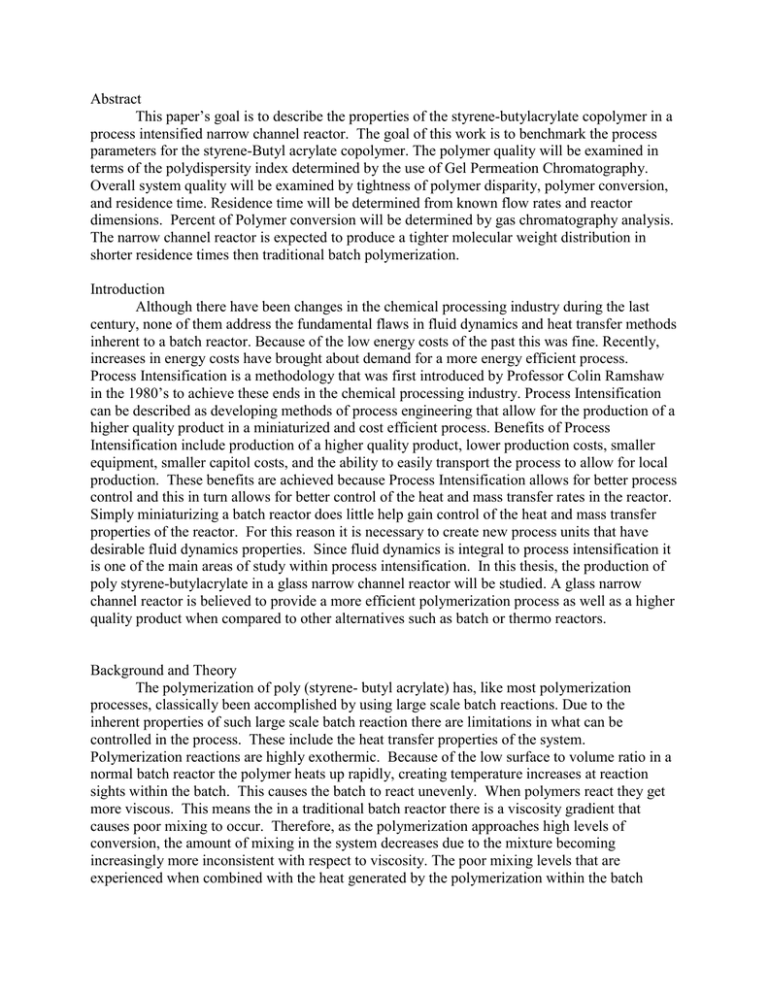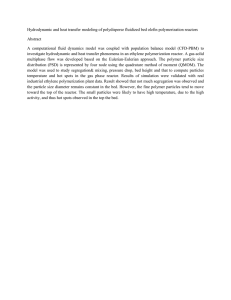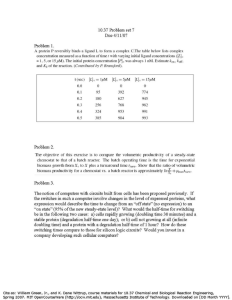Abstract This paper’s goal is to describe the properties of the... process intensified narrow channel reactor. The goal of this...
advertisement

Abstract This paper’s goal is to describe the properties of the styrene-butylacrylate copolymer in a process intensified narrow channel reactor. The goal of this work is to benchmark the process parameters for the styrene-Butyl acrylate copolymer. The polymer quality will be examined in terms of the polydispersity index determined by the use of Gel Permeation Chromatography. Overall system quality will be examined by tightness of polymer disparity, polymer conversion, and residence time. Residence time will be determined from known flow rates and reactor dimensions. Percent of Polymer conversion will be determined by gas chromatography analysis. The narrow channel reactor is expected to produce a tighter molecular weight distribution in shorter residence times then traditional batch polymerization. Introduction Although there have been changes in the chemical processing industry during the last century, none of them address the fundamental flaws in fluid dynamics and heat transfer methods inherent to a batch reactor. Because of the low energy costs of the past this was fine. Recently, increases in energy costs have brought about demand for a more energy efficient process. Process Intensification is a methodology that was first introduced by Professor Colin Ramshaw in the 1980’s to achieve these ends in the chemical processing industry. Process Intensification can be described as developing methods of process engineering that allow for the production of a higher quality product in a miniaturized and cost efficient process. Benefits of Process Intensification include production of a higher quality product, lower production costs, smaller equipment, smaller capitol costs, and the ability to easily transport the process to allow for local production. These benefits are achieved because Process Intensification allows for better process control and this in turn allows for better control of the heat and mass transfer rates in the reactor. Simply miniaturizing a batch reactor does little help gain control of the heat and mass transfer properties of the reactor. For this reason it is necessary to create new process units that have desirable fluid dynamics properties. Since fluid dynamics is integral to process intensification it is one of the main areas of study within process intensification. In this thesis, the production of poly styrene-butylacrylate in a glass narrow channel reactor will be studied. A glass narrow channel reactor is believed to provide a more efficient polymerization process as well as a higher quality product when compared to other alternatives such as batch or thermo reactors. Background and Theory The polymerization of poly (styrene- butyl acrylate) has, like most polymerization processes, classically been accomplished by using large scale batch reactions. Due to the inherent properties of such large scale batch reaction there are limitations in what can be controlled in the process. These include the heat transfer properties of the system. Polymerization reactions are highly exothermic. Because of the low surface to volume ratio in a normal batch reactor the polymer heats up rapidly, creating temperature increases at reaction sights within the batch. This causes the batch to react unevenly. When polymers react they get more viscous. This means the in a traditional batch reactor there is a viscosity gradient that causes poor mixing to occur. Therefore, as the polymerization approaches high levels of conversion, the amount of mixing in the system decreases due to the mixture becoming increasingly more inconsistent with respect to viscosity. The poor mixing levels that are experienced when combined with the heat generated by the polymerization within the batch leads to temperature gradients and hot spots in the batch. The temperature difference that is created causes different portions within a single batch to experience a different process and in effect different products. This occurs in a random way causing control to be impossible. The range of product that is created is evaluated in terms of the molecular weight distribution. The heat transfer and mixing characteristics of a batch polymerization process causes the molecular weight distribution to become more widely distributed. Product quality in polymers is considered to be lower for broader molecular weight distributions due to a higher degree of variability in physical properties. Improvements in the reactor design for polymerization reactions would lead to better process control causing product quality improvements. The mindset associated with Process Intensification is ideal for approaching this problem. Process Intensification can be described as shrinking the focus down to the molecular level to find fluid dynamic, heat transfer, and mass transfer characteristics that would improve the process for one molecule and finding methods to produce those characteristics in a continuous process with shorter residence times to reach high conversions. In reactor design methods to accomplish this include using narrow channel flow or by creating thin films in a spinning disk or rotating tube reactor. These methods produce environments that have large interfacial area to volume ratios. This creates an environment where the molecules can constantly be close to each other creating the ideal conditions for a quick reaction. Also, a large surface area is conducive to good heat transfer causing a more even reaction to take place. This in turn causes less viscosity variation and more even mixing. The ability to have increased reaction rates due to good mixing and decreased diffusion path length along with greater control over the heat transfer characteristics of the system leads to a process that will produce high conversion at a faster rate while allowing improved control over the temperature distribution in the system. The improvement in control over the process allows for production of a consistently higher quality product in a continuous manner. In addition there are many advantages to having a process intensified reactor on the large scale. Because of the larger surface area, heat transfer will be more efficient lowering energy costs The reduction in reactor size serves to lower capital costs by decreasing the space the reactor takes up and also decreasing the cost of the reactor. The reactor could be made small enough that it could become a portable process that would allow polymers to be manufactured where needed substantially lowering shipping costs. Using process intensification techniques to carry out photo polymerization reactions in a narrow channel reactor is a process that has been studied, but not been optimized for the Co butyl acrylate-styrene or any copolymer. However, study of the effects of processing conditions on conversion and polydispersity index of the product is necessary in order to optimize the process. Once knowledge of the effects of the relevant process variables on the end product is known a system to control these variables can be implemented to create a more controlled and more efficient process than what is used in today’s industry. The use of UV irradiation is a highly efficient means for giving monomers the activation energy to polymerize. The creation of large quantities of radical species produces drastic increases in polymerization rates. Although UV light does not penetrate liquids well, it is still a viable means of producing radical species in the intensified reactors due to the small path length across the fluid. Due to the depth of a traditional batch reactor, simply supplying the activation energy by UV light would make the process less efficient. Use of the intensified reactors provides a system that is easily penetrated by the UV irradiation and therefore solves the depth issues. The main factors that affect the rate of initiation are the light intensity, thickness of the sample, absorptive and concentration of the photo initiator being used and the number of initiating species that are produced for each photon of light (quantum yield). All these will be varied in order to optimize the system. For any copolymer reaction it is important to optimize the reaction by ensuring that all the monomers are used up. To this end the anisotropic composition will be calculated using the reactivity ratios of the monomers. Procedure The first part of the experiment is the purification of both the styrene and butyl acrylate monomers. This is necessary to remove the inhibitors that Sigma Aldrich places in their products, and is accomplished by placing the monomers (separately) in a separator funnel and then passing them through an Aldrich inhibitor removal column. 600 ml of the styrene is purified along with about 185ml of Butyl-Acrylate. Now, the appropriate weight ratio of photoinitiatior is weighted out in the dark. It is then placed in a tinted Erlenmeyer flask and the cover is placed back on top. Next the monomers are placed in a large nontinted Erlenmeyer flask and covered. The cover has on it a pressure release valve in the open position a second tube leading to the photo initiator flask and a third tube leading to a nitrogen tank. Place toluene in a smaller, nontinted Erlenmeyer flask and place upon it a similar cover. Place a stir bar apparatus under, and stir bars in, all 3 beakers. With stir bars placed, purge the sample using nitrogen. While purging continuously stir the samples. After half an hour, close the pressure release valve on the monomer flask while leaving the nitrogen on. This will transfer the monomer to the photo initiators tinted flask. Wait until 600 ml of the monomer have been transferred and then open the pressure release valve. Repeat this procedure for 150 ml of toluene. Stir the solution in the tinted beaker for 5 minutes using the stir bar. The monomer solution is now ready. This beaker should have 3 tubes coming out of the top cover. Two of the tubes were used to transport the monomer and toluene solutions. The third should be connected to and HPLC pump. Next take a fourth Erlenmeyer flask and fill it with 500ml of toluene. It should then be covered with a glass cover with one tube. The tube should be connected to a 2 way valve connected to the feed beaker. With the 2 way valve pumping toluene turn on the HPLC pump and run it for 2 minutes. Now, place a sheet of metal over the reactor and turn on the UV light and wait 3 minutes. Next, turn the 2 way valve to the feed direction and wait 2 minutes. Remove the metal sheet and record the initial temperature of the feed coming out of the reactor. Record the temperature once a minute until the process reaches steady state. Using a small (10ml) vial, with 10 drops of a 20ml THF with 4 grams hydroquinone solution inside, collect a sample. The collected samples must then be analyzed for, Mn, Mw, Pd, structure, and percent conversion. The first 3 are done using GPC analysis. For this process take a sample and inject it into a GPC device. The GPC analysis uses an Integrated Laboratories PL-GPC 50 Integrated GPC system. Two mixed bead columns of poly-divinyl-benzene-co-styrene are used to analyze the solution and tetrahydrofuran is used as the solvent flowing at one mL/min. The GPC utilizes a refractor index detector in its analysis to determine when the polymer has passed through the column. The molecular distributions and weights are calibrated using known samples with known characteristics to create the calibration curve in the program. For the last 2 NMR is required. The UV intensity is measured using a Dymax Accu-cal 30 UVA Power and Dose Meter. Once all the data is collected the process can be optimized. Future work Future work in Photo polymerization will include studying other polymers in both the narrow channel reactor and the rotating tube reactor. Other work could include the redesign of both the narrow channel and rotating tube reactors to make them more commercially friendly. Also, both a large and small rotating tube reactor could be designed and optimized to cover the needs of industry and small scale producers. Time table The first thing that needs to be done is I need to become familiar with the experimental setup and become competent in doing all things necessary to perform a good experiment. Once done, a literature review will be preformed to learn how to appropriately analyze the copolymer samples. This will be followed by data collection using the narrow channel reactor. four photo initiator concentrations will be studied. Next, four UV intensities will be studied. This will be followed by studying 3 different water bath temperatures and then different reactor lengths and diameters. Data collection for all these parameters is expected to take 5 months and last into November. Each run is expected to take two days. The remainder of my time here will be dedicated to writing my thesis. References Beckingham, Brian. “Photo Polymerization Using Process Intensificaion”. March 2006. Iwasaki, Takeshi; Yoshida, Jun-ichi. “Free Radical Polymerization in Microreactors. Significant Improvement in Weight Distribution Control.” Macromolecules 2005, 38, 1159-1163. Decker, Christian. “The Use of UV Irradiation in Polymerization.” Polymer International (1998) 0959-8103.




